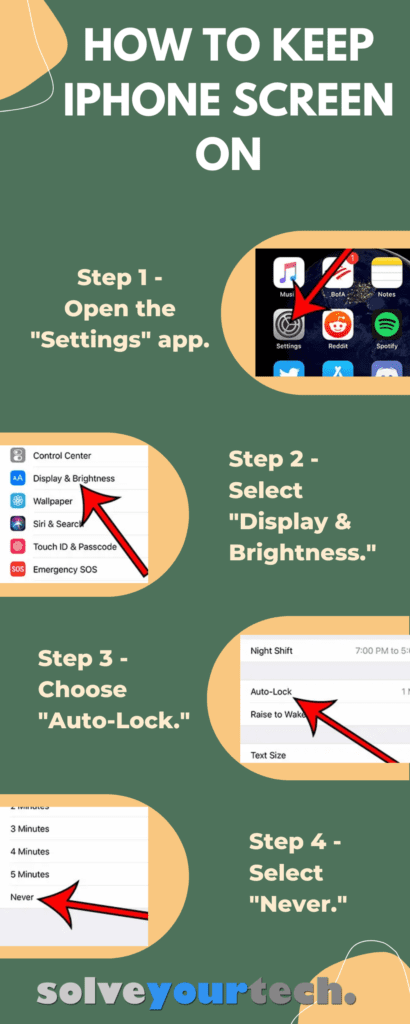To ensure your iPhone screen remains constantly visible, make use of the Auto-Lock feature in your iPhone’s settings.
Start by navigating to ‘Settings.’ From there, proceed to ‘Display & Brightness’ and then select ‘Auto-Lock.’ Choose the ‘Never’ option in the Auto-Lock settings. This will prevent your iPhone screen from turning off automatically, keeping it on at all times. Remember to adjust this setting if you wish to save battery life in the future.
Additionally, if your iPhone has an ‘Always on Display,’ you can turn that on or off by going to Settings > Display & Brightness > and toggling the ‘Always On Display’ setting.
Our guide continues below with additional information about how to keep iPhone screen on settings, including pictures of these steps.
You can also check out our how to keep iPhone screen on video on YouTube for more information.
iPhone – Keep Screen On
- Open Settings.
- Choose Display & Brightness.
- Tap the Auto-Lock button.
- Select Never.
You can continue reading below for additional information on how to make the iPhone screen stay on for longer periods of time.
Deal of the Day
- HIGH-QUALITY SOUND — Powered by the Apple H1 headphone chip, AirPods deliver rich, vivid sound.
- EFFORTLESS SETUP — After a simple one-tap setup, AirPods are automatically on and always connected. They sense when they’re in your ears and pause when you take them out. And sound seamlessly switches between your iPhone, Apple Watch, Mac, iPad, and Apple TV.
Last update on 2025-07-02 / Affiliate links / Images from Amazon Product Advertising API | As an Amazon Associate, I earn from qualifying purchases.
Your iPhone screen probably turns off after 30 seconds or a minute of inactivity. This can be overridden when playing a game or watching a video, but regular usage patterns will cause the screen to turn off that quickly.
Under normal circumstances, your iPhone will automatically turn off the screen and lock the device is a benefit.
Related: Do iPhones Automatically Change Time Zones?
Reducing the time that the screen is on will help you get more life out of a battery charge and prevent accidental pocket dials and other problems that can occur when an iPhone is in a pocket or bag with an unlocked screen.
But situations can arise where you need the iPhone screen to stay on for a longer period because you are looking at the screen without physically interacting.
Fortunately, you control the setting that causes your iPhone screen to turn off and lock automatically.
Our guide below will show you where to find this setting so that you can keep your iPhone screen on until you manually elect to lock it.
Related Topic: Are people getting blurry photos from you? Our blurry pictures on iPhone tutorial can show you some settings to change to try and fix that.
How to Keep the iPhone Screen On Until You Manually Lock It (Guide with Pictures)
The steps in this article were performed on an iPhone 7 Plus in iOS 12.3.1. Note that these same steps also work on newer iPhone models and newer iOS versions as well, such as the iPhone 13 and iPhone 14 and iOS 15 and iOS 16.
If you are using an older version of iOS and this setting is not located on the menu indicated in these steps, then continue to the next section, where we will show you how to locate this option in some older versions of iOS.
These steps will show you how to make your iPhone screen stay on longer.
Step 1: Touch the Settings icon.
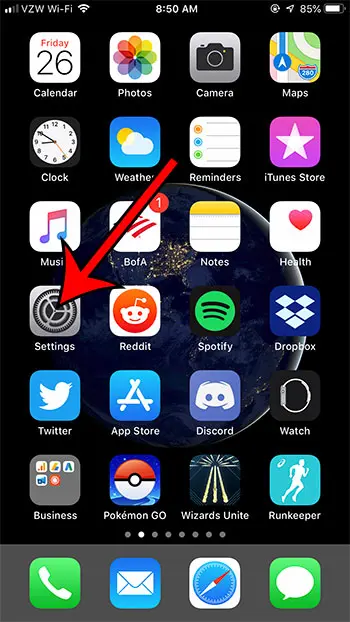
Tap the gray gear Settings icon.
If you don’t see the Settings app on your Home screen, then you can swipe down on your Home screen and search for “settings.”
Step 2: Scroll down and open the Display & Brightness menu.
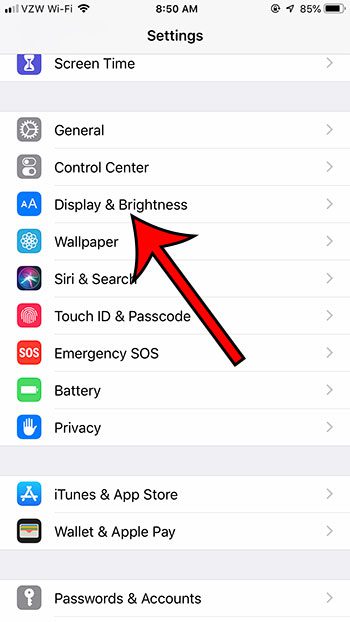
Touch the Display & Brightness option.
This is also the same menu that you would choose if you wanted to switch between light and dark mode.
Step 3: Select the Auto-Lock option.
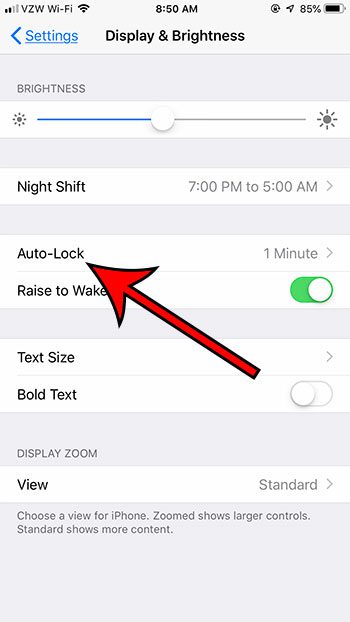
Tap the Auto-Lock button.
The amount of time shown next to this button is the current amount of time that your phone waits before shutting off the screen.
Step 4: Tap the Never button to prevent your screen from turning off automatically.
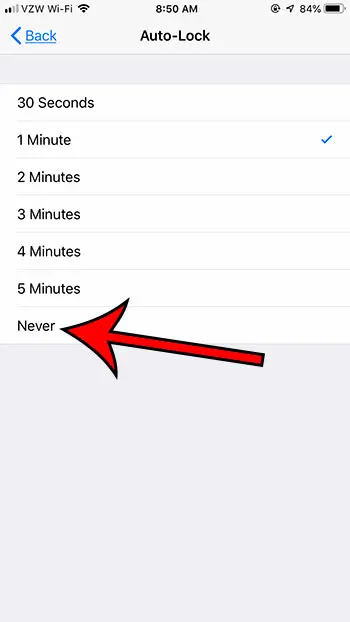
Select the Never option to stop your screen from turning off automatically.
Once you select “Never” your iPhone will no longer turn off on its own. You will need to lock the screen yourself by pressing the side button.
As mentioned above, the section below will show you how to keep the iPhone screen on in the older versions of iOS.
Is your screen rotating all the time and you want it to stop? Then check out this portrait orientation lock guide to learn more about this feature.
Here is how to keep your iPhone screen from turning off (legacy iOS versions)-
- Open the Settings menu.
- Open the General menu.
- Select the Auto-Lock option.
- Select the Never option.
These how to keep screen on iPhone steps are also repeated below with pictures –
Step 1: Tap the Settings icon.
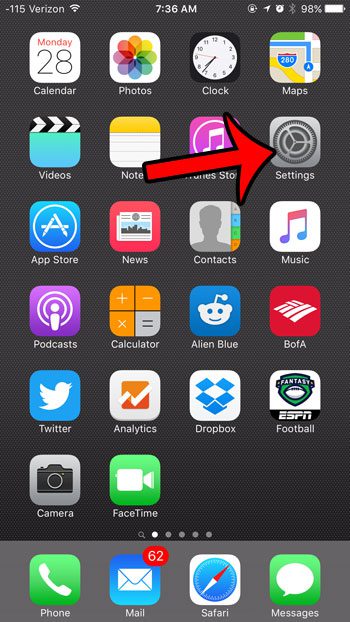
Step 2: Scroll down and tap the General option.
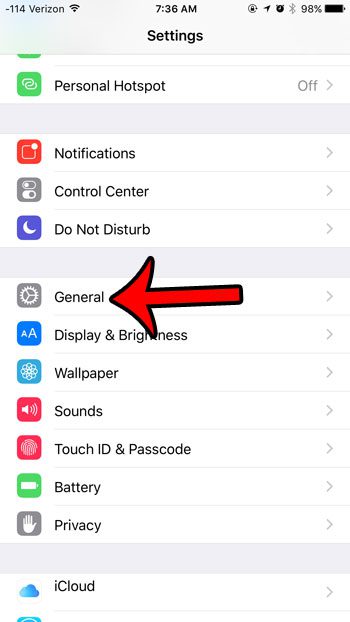
Step 3: Tap the Auto-Lock option.
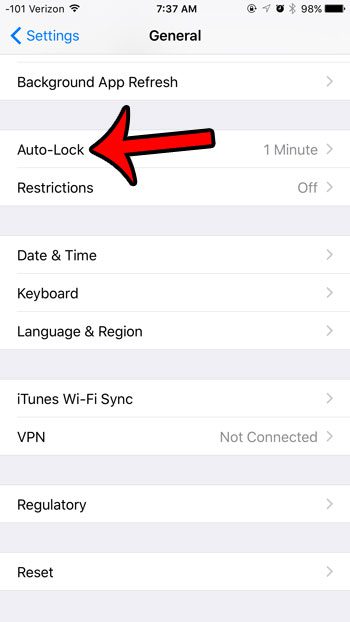
Step 4: Tap the Never option.
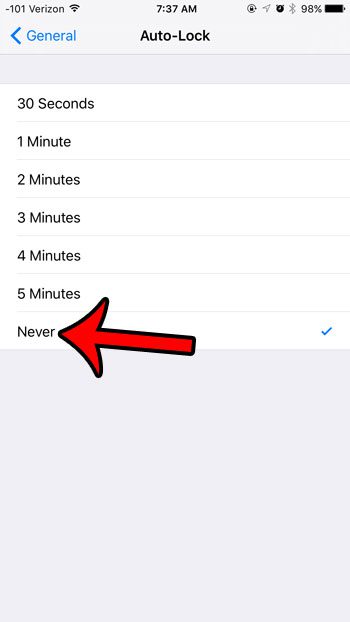
Our tutorial continues below with additional discussion on changing the iPhone auto lock setting.
You can also read our how to change screen timeout on iPhone guide for additional discussion on this topic.
More Information on How to Leave iPhone Screen On for Longer Periods of Time
Your iPhone screen will now stay on until you elect to manually turn it off and lock the screen. You can do this by pressing the Power button on the top or side of your iPhone. Note that keeping the iPhone screen on for long periods of time is one of the biggest ways to drain your battery.
The different amounts of time that are available for the iPhone’s auto-lock setting are:
- 30 seconds
- 1 minute
- 2 minutes
- 3 minutes
- 4 minutes
- 5 minutes
- Never
If you aren’t able to find the Settings app on your Home screen, then you can also tap the Search button at the bottom of the Home screen or swipe down, then type the word “settings” into the search field to find the app that way. This guide about the iPhone Settings app discusses more about this.
If you need to keep your iPhone display on for more extended periods but are concerned about the added battery drain, then you can try reducing the brightness.
You can find a brightness slider on the Control Center, accessible by swiping down from the top-right corner of your screen. The Brightness option is a vertical bar with a sun icon on it. Moving the slider lower makes the screen dimmer, which uses less battery.
If you need to know how to turn off zoom on an Apple Watch, then this SolveYourTech guide can help.
Since keeping the iPhone screen on all the time is not only a battery issue but a security issue, it’s very important to get in the habit of pressing the Power button to lock the screen manually when you are done using your iPhone.
If you don’t have a passcode set up for your device, or you haven’t enabled Touch ID or Face ID, then you can do so by going to the Settings > Touch/Face ID & Passcode menu.
Have you been noticing that your iPhone settings change slightly when your remaining battery percentage gets low? Learn why your iPhone battery icon is yellow, and see what other settings are affected, as well as how you can turn this option on or off manually.
Frequently Asked Questions About How to Keep iPhone Screen On
How do I make my iPhone’s screen not lock automatically?
Your iPhone has an “auto lock time” setting that controls how long of a period of inactivity needs ot occur before the screen locks on its own.
This is a good way to save battery life, and it’s actually one of the items that Low Power Mode affects when you turn that on.
You can adjust the lock screen time if you open Settings, tap Display & Brightness, choose Auto-Lock, then select a different option.
Choosing Never will make your iPhone’s Home screen remain on until you lock the screen manually.
How do I lock the screen orientation on my iPhone?
Many iPhone users can run into problems where the device is rotating when they don’t want it to.
One way that you can fix this is to enable something called portrait orientation lock. You can find this button by opening the Control Center, then tapping the button that looks like a lock with a circle around it.
Your iPhone will then remain in portrait orientation until you go back and manually press the portrait orientation lock button again.
On iPhone models without a Home button, you can open the Control Center by swiping down from the top-right corner of the screen.
On iPhone models with a Home button, you open the Control Center by swiping up from the bottom of the screen.
How come my iPhone screen dims after a certain period of time?
Your iPhone screen uses a lot of battery, so the device does everything it can to conserve that battery.
This includes dimming the screen when you haven’t touched it in a while, or if you aren’t looking at it.
This is controlled by the “Auto-Lock” setting, which you can find at Settings > Display & Brightness > Auto-Lock.
If your iPhone seems to be stuck in the portrait orientation, then you can read our how to rotate the screen on an iPhone 7 guide for some things to check.
How to Change the iPhone Auto Lock Option Infographic
Related: How to Enable Javascript on an iPhone
Video About How to Keep the iPhone Screen On
If you’re wondering about the difference between iMessages and text messages, then our sent as text message tutorial can answer your questions.
Conclusion
A balance needs to be struck between using your iPhone’s features while also ensuring that the phone lasts all day.
These two goals work against one another, however, as the screen will drain the battery pretty quickly.
Apple makes the iPhone turn off after a period of inactivity by default. Still, you can keep the iPhone screen on longer, even indefinitely, by changing the setting we discuss below.
Continue Reading
- How to Remove the Picture from an iPhone Lock Screen
- Why Isn’t My iPhone 7 Screen Turning Off?
- iPhone Black Screen But Still On

Matthew Burleigh has been writing tech tutorials since 2008. His writing has appeared on dozens of different websites and been read over 50 million times.
After receiving his Bachelor’s and Master’s degrees in Computer Science he spent several years working in IT management for small businesses. However, he now works full time writing content online and creating websites.
His main writing topics include iPhones, Microsoft Office, Google Apps, Android, and Photoshop, but he has also written about many other tech topics as well.

